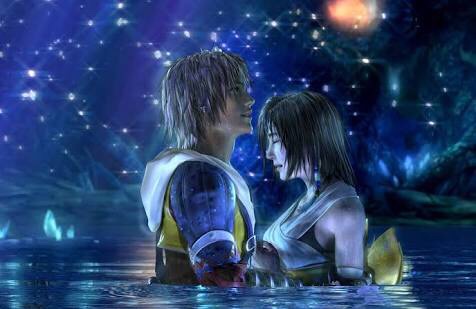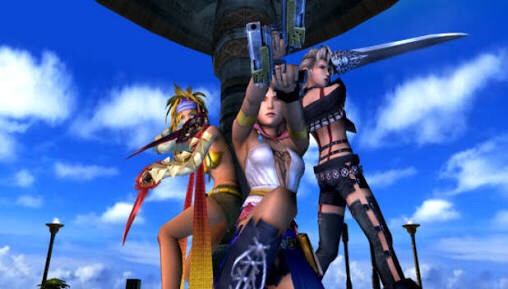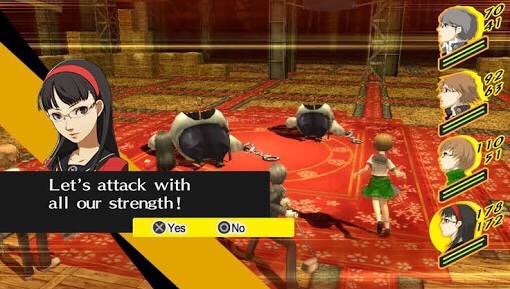 Hello, gentle readers, and welcome to the RPG Reload, the regular feature where we always have an adventure in our pocket. To be specific, welcome to the RPG Reload Glossary, where we sift through the piles of historical debris and messy semantics to try to make some sense of it all. This time around, we’re continuing our look at the history of the JRPG sub-genre. In the last part, we covered the debut of two of the biggest JRPGs of the 1990s and the subsequent boom in popularity for the genre worldwide. As the thousands digit rolled over on the calendar, people were throwing parties everywhere. Nintendo was awash in the surprising global success of Pokemon, providing the company with a valuable crutch in the face of a weakening console business. Square was virtually on top of the gaming world. The next ten years would prove vital for both companies, and the fortunes of both companies would have a major impact on the now-trendy JRPG genre.
Hello, gentle readers, and welcome to the RPG Reload, the regular feature where we always have an adventure in our pocket. To be specific, welcome to the RPG Reload Glossary, where we sift through the piles of historical debris and messy semantics to try to make some sense of it all. This time around, we’re continuing our look at the history of the JRPG sub-genre. In the last part, we covered the debut of two of the biggest JRPGs of the 1990s and the subsequent boom in popularity for the genre worldwide. As the thousands digit rolled over on the calendar, people were throwing parties everywhere. Nintendo was awash in the surprising global success of Pokemon, providing the company with a valuable crutch in the face of a weakening console business. Square was virtually on top of the gaming world. The next ten years would prove vital for both companies, and the fortunes of both companies would have a major impact on the now-trendy JRPG genre.
To repeat the note from last time: due to the immense size of this particular sub-category, I’m going to be focusing on only the titles that were critical to the development and/or popularization of the genre. This is a necessary move to keep this particular historical retelling from growing to an absurd size.

Only a few months into the year 2000, Sony’s PlayStation 2 made its debut in Japan. By the end of the year, it would be released in every major gaming market. While Sony’s first console had debuted with a cloud of uncertainty about it, there were no doubts about the PlayStation 2. It was the chosen one, the fated son. The sheer weight of its hype alone was enough to crush SEGA’s final console, the Dreamcast. Whether to support Sony’s console or not was barely a decision at all for third parties. Certainly Square, who had benefited more than most from the PlayStation, did not hesitate for a second. They were already well into development on Final Fantasy 10, a $40+ million production that would launch exclusively for the PlayStation 2 just a year after its launch. At the same time Final Fantasy 10 had been announced, Square also announced Final Fantasy 11, which was said to be an online game. While it’s more of an action-RPG than a JRPG, it’s useful to mention that Square’s collaboration with Disney, Kingdom Hearts, was announced early in the year 2000 for the PlayStation 2, solidifying Square’s commitment.
Flush with cash and courage, Square had been dipping their toes into a lot of unfamiliar pools since the smash success of Final Fantasy 7. With their recent games going in hard on cool-looking cinematics and wild stories, more people than ever were asking Square about when a Final Fantasy movie was coming. Square finally decided to grant those wishes, announcing a full-length Final Fantasy film in 1998 for release in 2001. Hironobu Sakaguchi, the man who had dropped out of university to work in a little game studio for an electric company, suddenly found himself directing a major motion picture with a $137 million budget. Final Fantasy: The Spirits Within was a technically-impressive production that offered some of the most spectacular computer graphics seen to date, married with a story that didn’t seem to have much to do with Final Fantasy. The film was not well-received and ultimately lost a ton of Square’s money, enough that Sony had to come to the rescue by buying a portion of the company.
Hironobu Sakaguchi, the father of Final Fantasy, was for all intents and purposes benched from his vice-president position as a result of this failure, and only a few years later, voluntarily resigned from Square. Just like that, Square’s apple cart had been shoved onto its side. This may look like an overreaction from the outside, but The Spirits Within had nearly cost the company more than anyone knew. It wasn’t known publicly at the time, but Square and Dragon Quest creator Enix had been discussing a merger. Enix had money but lacked Square’s reach and fully-owned IP. For Square’s part, they would gain access to Enix’s significant resources. The failure of The Spirits Within had made Enix reconsider the deal, though it would ultimately come to pass in 2003.
On the gaming side, things were a little better. Final Fantasy 10 had been a big success in spite of criticisms about its lack of an overworld map. Final Fantasy 11 ended up releasing in 2002 and went on to be one of the company’s biggest moneymakers. After the success of Final Fantasy Tactics, Sakaguchi had picked its director, Yasumi Matsuno, to head development on Final Fantasy 12, which began production in 2000. Kingdom Hearts had been an immediate smash hit for Square upon its debut in 2002, and Square was even back in Nintendo’s good graces thanks to their support of the Game Boy Advance and a token effort for the Gamecube. All in all, the PlayStation 2 era was good to JRPG publishers like Square. Most major efforts from publishers were localized, and the few that slipped through the cracks were picked up by companies like Atlus.

Looking at handhelds, the Pokemon series kept right on going well past the point that many had expected. No mere fad, the mainline games in the series kept the lights on for Nintendo during some very dark times. By this point, the Game Boy had finally been retired, with its successor, the Game Boy Advance, doing brisk business. It was clear that the handheld business was good for Nintendo, and that competing against them would be a nearly impossible task. But Sony had done it before elsewhere, and they wanted to do the same again. The announcement of the Sony PlayStation Portable almost certainly cut the Game Boy Advance’s life short as Nintendo scrabbled to put together something that could compete more effectively. I doubt anyone at the time realized just how much the PSP and Nintendo’s Nintendo DS would change the landscape of Japanese gaming, and by extension, the JRPG genre.
But let’s pop back over the now post-merger Square Enix. While Sony and Nintendo were preparing their new hardware in 2004, Square Enix was dealing with an increasingly large tire fire on their main franchise. Final Fantasy 12 had by now been in development longer than any other game in the series, and it was nowhere close to being finished. Matsuno was suffering from severe health issues, and the game’s ambitions appeared to be far greater than the team could realistically deliver. Mid-way through 2005, Matsuno announced that he was stepping down from the troubled production for health reasons, with consummate company man Akitoshi Kawazu picking the project up to bring it to completion.

The severe delays on Final Fantasy 12 had caused a lot of issues for the company. While a direct sequel to Final Fantasy 10 released in 2003 had served as a decent stop-gap, the plans for the future of the franchise were stuck in limbo until Final Fantasy 12 could sort itself out. Final Fantasy 13 had originally been planned as a PlayStation 2 game, but it was becoming clear as time went on that it would have to be moved to the next generation of hardware due to the tardiness of the previous game. Luckily, now that they were merged with Enix, the company had another reliable moneymaker.
Dragon Quest 8 made its debut in Japan in 2004, with a Western release the following year. Not only was its development time shorter than that of the previous game, the resulting game was immediately more impressive than a Dragon Quest game had been in some time. Not only did it feature an explorable overworld, the game’s world was rendered to scale with the player. The game felt unbelievably huge, more so than just about any JRPG had to date. This bit of technical wizardry can largely be ascribed to the efforts of co-developer Level-5. With a game this attractive, Dragon Quest could finally have a chance in the West, it was believed.

Square Enix pulled out all of the stops with the international version. They had new menus created that would appeal more to Western players. Voice acting was added to the game to help it feel more cinematic. The music was replaced with orchestral versions, and as the cherry on top of the sundae, the hero was given a special Goku-like hair-style when he was fully powered-up in battle. By this time, Dragon Ball was a big deal in the West, so the connection was certainly worth marketing. Square Enix also gave the game the best promotional weapon they had at their disposal: every copy of Dragon Quest 8 would come with a special Final Fantasy 12 demo. While still a long ways off from its Japanese success, Dragon Quest 8 sold very well indeed. Square Enix, Level-5, Sony, and a whole lot of others made some good cheddar from the game.
With Kawazu in place, Final Fantasy 12 wrapped up fairly quickly. It ended up releasing in early 2006 in Japan, with a Western release following later in the year, just before the launch of the PlayStation 3 and Nintendo Wii. While the game felt unfinished in some ways, its impressive scale went over well with a crowd that had already been pleased by Dragon Quest 8 the year before. Sales didn’t quite match up to the critical reception, but by this point, Square Enix was likely just happy to have the game on the shelves. With any luck, Final Fantasy 13 would have a smoother development. Well, we know how that story ends, but we’ll get there soon enough.

The handheld gaming market had exploded over the last couple of years. Nintendo’s DS was successful on a scale that no one could have predicted, selling through massive numbers everywhere but especially in Japan, where it became the de facto game player of choice. Sony’s PSP was struggling in other regions, but it had found a good home in second place in Japan, building up a library and audience among the few gaps in the DS’s market. The home console market was showing great signs of weakness in Japan compared to other territories, and as a result, many Japanese developers opted to focus on handhelds. It didn’t hurt that the average budget for a handheld game was far lower than that of a console game, particularly in consideration of the upcoming PlayStation 3. The jump to HD gaming brought with it an exponential increase in costs, and few Japanese publishers were comfortable rolling that kind of money on unproven new consoles.
It was a particular problem for JRPGs. The genre had spent the last decade on the cutting edge of both visuals and content quantity. With the amount of assets the average JRPG uses, the costs of producing similarly gorgeous titles on the new hardware standards were scary. Worse yet, with Japanese gamers mostly interested in handheld gaming, such games would have to rely more on the Western audience than ever. But what could Square Enix do? If Final Fantasy didn’t look amazing, would its audience still be interested? While most other publishers opted to move their JRPG franchises to handhelds or quietly retire them altogether, the Square side of Square Enix went full steam ahead on consoles.

At the E3 show of 2006, just ahead of the international release of Final Fantasy 12, Square showed the first demonstration of Final Fantasy 13, which would release on Sony’s PlayStation 3. They hoped to have a playable demo by the next show, and while they didn’t state a release date, it was expected to arrive in the first couple of years of the system’s life. They also announced that there would be a collection of titles built around Final Fantasy 13‘s mythos. Prominent among the announced titles was Final Fantasy Versus 13, a production headed by Tetsuya Nomura. That game eventually released late last year as Final Fantasy 15, so you can probably guess how this is all going to go from here.
But the international release of Final Fantasy 12 wasn’t the last big news of the year for JRPG fans or Square Enix. A couple of weeks later, Square Enix dropped the absolute bombshell that the upcoming Dragon Quest 9 would not be releasing for the PlayStation 3, or the Nintendo Wii, or the Xbox 360. Instead, it was being developed exclusively for the Nintendo DS. It made a lot of sense in one way, as series creator Yuji Horii has always expressed an intention to release the games on the most popular platforms, but seeing the original king of the JRPG genre going to the little under-powered DS was enough of a surprise that gaming message boards across the internet had to break out the smelling salts. That game eventually released in the summer of 2009, though by then Square Enix had once again lost their stomachs for localizing Dragon Quest and the job fell to Nintendo. The game was a huge success, with its multiplayer component proving particularly popular.

Over on consoles, Final Fantasy 13‘s development continued to stretch out. The game eventually released in December of 2009 in Japan, with an international release a few months later. The game was heavily criticized for its linearity and absurdly-slow ramp-up. Most of the praise for the game was heaped onto its clever new battle system, and players who stuck with it long enough found one area’s size to be more in line with what they had been hoping for. Visually, the game looks great, but it’s also really disjointed and inconsistent. It turns out that artists had just been churning out content with no proper consideration for how it all was meant to stitch together, just one of many curious practices in the game’s development. The game sold decently, but certainly not as much as Square Enix was likely hoping for. The assets ended up being re-used for two sequels that helped pad out the rest of the generation while Square tried to figure out what they were going to do next.
In truth, a new sort of genre appeared to have wrested the ball away from JRPGs in Japan for a while. Capcom’s Monster Hunter broke into the mainstream in Japan in a big way once it hit the PSP, and while it’s not strictly an RPG itself, its popularity wasn’t easily ignored. Many direct copies followed, while tons of games across other genres tried to adopt its multiplayer focus and structure built around relatively short, discrete missions. Behind all of this noise, smaller JRPG developers were still plugging away on lower-budget titles to reasonable success. Nippon Ichi Software, Idea Factory, and Atlus among others benefited from Square Enix’s fumbling. The latter was finally able to taste large-scale success worldwide with their newly-revamped take on Persona seen in Persona 3 and Persona 4 for the PlayStation 2. The latter was especially successful thanks in no small part to a high-profile playthrough by the good folks at GiantBomb.

Still, conventional wisdom was that the JRPG genre had mostly picked up sticks and moved to handhelds, taking the steps down in scale and budget that came with that move. Japan showed no signs of coming back to consoles, and the massive success of Dragon Quest 9 and the relative lack thereof by Final Fantasy 13 seemed to support that choice. We’ll take a look at where things went in the 2010s in the next, final installment of our JRPG history feature, coming next week. Thanks for reading!
Next Week’s Reload: The History of JRPGs, Part Five